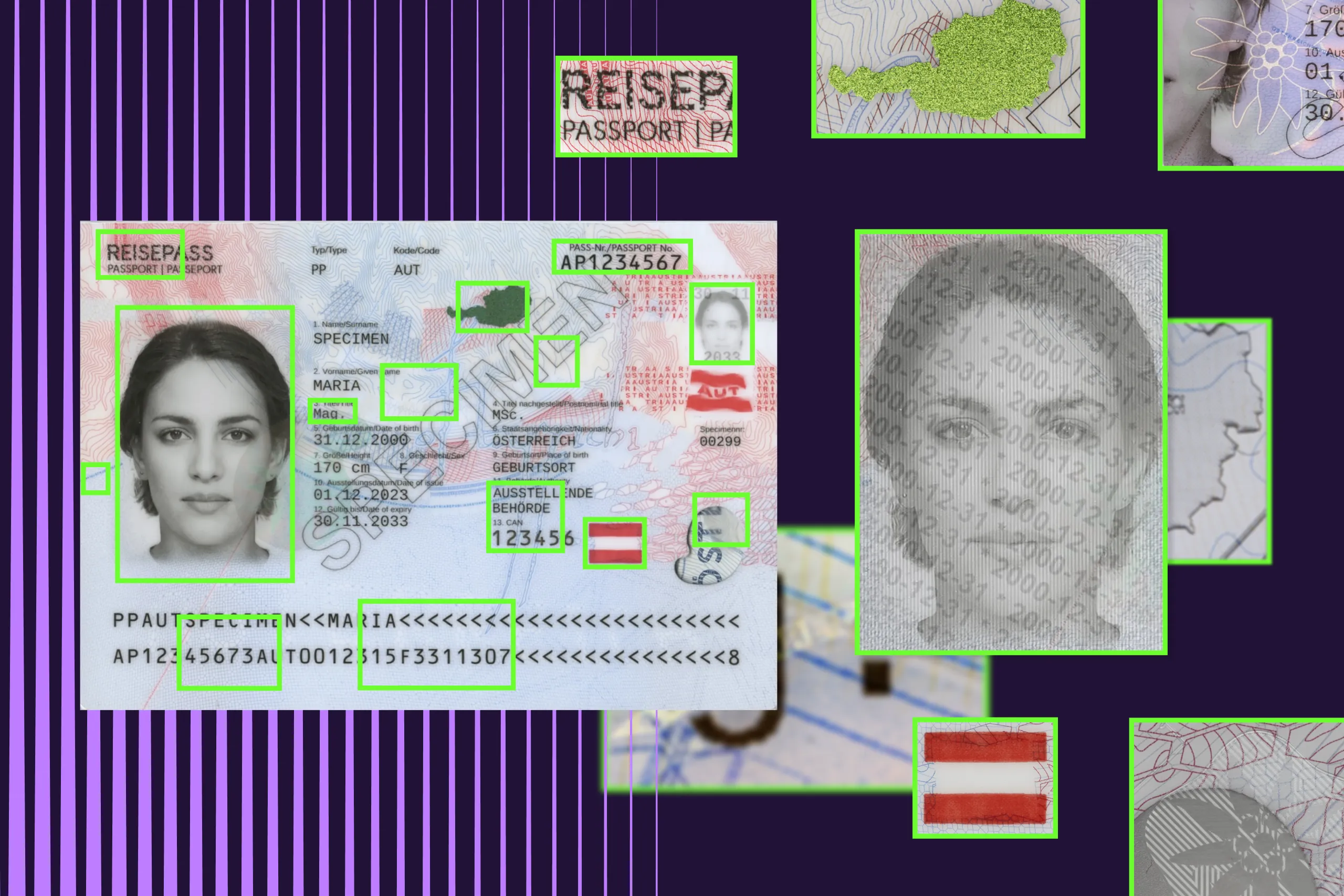As one of India’s closest neighbors, Sri Lanka shares some common features, such as their multi-lingual approach to text data in identity documents. However, as an independent state with a rich, unique culture, tradition, and history, it has its own zest.
In this article, we’ll scrutinize the most interesting attributes of Sri Lankan ID cards, driver’s licenses, and passports, and show the tricky parts of identifying travelers and customers who present them.
The challenges of processing Sri Lankan IDs
There are three main types of identity documents in Sri Lanka: a passport, national identity card, and driver’s license. Let’s see what obstacles you may encounter when processing them in your systems.
Data printed in three languages
Sri Lanka claims Sinhala and Tamil as official languages. English fills the role of the link language in the country. That’s why you can see trilingual governmental websites, as well as see these languages in domestic identity documents.

As you can see, the Sinhalese text requires more space on the webpage compared to English.
Both national languages have ornate alphabets that are significantly distinct from Latin. That means the OCR engine under the hood of your identity verification solution should recognize these writing systems.
This is what language combinations you may see in Sri Lankan IDs:
| Type of ID | Languages in use |
|---|---|
Passport | English, Tamil, Sinhala |
National identity card | English, Tamil, Sinhala, or Tamil and/or Sinhala only in older versions |
Driver’s license | English |
Multiple versions of a national ID card in circulation
First issued in 1972, a national ID card is the main proof of identity within the country for citizens aged 16 or older. In addition to personal data, this document contains the NIC (National Identity Card) number. Just like the Social Security Number in the US, the NIC is a key identification asset for Sri Lankan people during government procedures, including voting, financial operations (for example, opening a bank account), and police interactions.
Typically, ID cards remain valid until the document holder changes their legal status or residence. That means ID cards issued in different decades are currently in use.
What is the difference between them?
Since January 1, 2014, NICs must be issued in Tamil and Sinhala after the introduction of the corresponding supreme court order. Until 2014, there were also single-language ID versions, for instance, in Sinhala only.

A Sri Lankan national ID card in Tamil and Sinhala from 2014.
Such older versions of Sri Lankan ID cards are paper documents with lamination that complicate remote verification. The thing is that the personal data page can include entries in different fonts. Sometimes, the data is manually written, not printed. Also, there can be glare during the capture process due to the lamination.
On October 27, 2017, all newly issued Sri Lankan ID cards became trilingual, with data in the two national languages, plus English. Additionally, they got a landscape-oriented layout that replaced the previous generations of vertical documents. Also, this version has the ICAO standard photo of the document holder and security features such as a Guilloche pattern, hologram, elements printed in Optically Variable Ink, and a barcode on the reverse side.

Since 2017, Sri Lankan ID cards have been issued in three languages and have a landscape-oriented format.
The NIC number has also undergone its own evolution. Initially, it was a unique 9-character code containing digits and a letter, for instance, 911042754V. Here is how it’s decoded:
| 91 | 104 | 275 | 4 | V |
|---|---|---|---|---|
The year of birth | The number of days till the individual's date of birth. For women, +500 is always added to this number to code the holder’s gender, e.g., 604 in this example. | The serial number | The check digit | The “V” indicates the holder can vote. Otherwise, the code is completed with the “X” character. |
The number generation rule was changed on January 1, 2016. Now, the NIC consists of 12 digits (e.g. 197419202757), representing the following pieces of data:
| 1974 | 192 | 0275 | 7 |
|---|---|---|---|
The year of birth | The number of days till the individual's date of birth. For women, +500 is always added to this number to code the holder’s gender, for example, 692 in this case. | The serial number | The check digit |
In the visual zone of a Sri Lankan ID card, you can find the holder’s name, address, gender, the date and place of birth, and the document issuance date. In the 2017 version, all this information is encoded in a barcode with a PDF 417 format.
The earlier versions also have the purple number (1-9) on the front side placed next to the Sri Lankan emblem, referring to one of the nine provinces of the state where the ID was issued.
Postal ID cards in Sri Lanka
While all national identity cards in the country are issued by the Department for Registration of Persons, there is one more issuing body—the Department of Post. This authority is eligible to issue postal identity cards. This type of domestic identity document is primarily designed for conducting financial transactions via post offices.
A postal ID card containing the bearer’s photo, personal data, and signature is still valid proof of identity. According to the Department of Posts announcement, it’s expecting to issue a more secure and modern version of the document in future.
English-only driver’s licenses
Unlike identity cards, all driver’s licenses in Sri Lanka are issued in English only. The data set includes the holder’s name, place of residence, date of birth, blood group,etc. On the reverse side is a table with information on the vehicle categories for which the document is valid, along with the issuance and expiration dates per category.
There are now two valid versions of the document in circulation—from 2009 and 2023.

The layouts of Sri Lankan driver’s licenses from 2009 (above) and 2023 (below).
The amended version has a slightly modified design and additional security features: a hologram printed on the bearer’s photo, and a QR code with the license number embedded. Both series include an optically variable device on the front side.
Sri Lankan driver’s licenses are valid for eight years from the date of issuance.
The processing of the country’s driver’s license includes reading personal data in the visual inspection zone and QR code (for the 2023 series). The presence of dynamic security features also makes it possible to conduct a liveness check for the document.
Extra long names beyond the MRZ code
Finally, Sri Lankan citizens have a passport as a travel document compliant with ICAO standards. Currently, the country issues non-biometric passports, but the electronic version is expected to launch at the end of 2024.

Sri Lanka is going to begin issuing biometric passports by the end of 2024.
The document includes data fields in the Sinhalese, Tamil, and English languages, and all personal data in English. In addition to standard information, such as name and date of birth, the passport also contains the profession on the personal data page. For instance, you may see “accountant,” “counselor,” or “student” in this data field. If the bearer doesn’t have a job, the line is empty.
Another peculiarity you may face when verifying a Sri Lankan passport is several names that are sometimes quite long. The “Other names” data field may include one other name, or even five names at once. As a result, the first line of the machine-readable zone, including the full name of the passport’s holder, can look a bit messy if the length of the name exceeds the 44 character limit.
The observation and alterations page in a Sri Lanka passport
As the issuing body, the Department of Immigration and Emigration enables passport holders to apply for amendments in their valid documents. These include a change of name or profession, deletion of a child’s name, etc. Once the request is accepted, the amendments will be added to the observation and alterations page in the document.
The security features used in the passport which can be checked during remote verification are the ghost photo, hologram, and Invisible Personal Information (IPI).
Subscribe to receive a bi-weekly blog digest from Regula
How to effectively process Sri Lankan IDs
Summing up, verifying identities of citizens of Sri Lanka requires a powerful identity verification solution that performs the following tasks:
Recognition of data in Tamil and Sinhala
Verification of a variety of national ID cards, driver’s licenses, and passports (a large document template database with all the specimens added is a must)
Checks of the presence of security features: IPI, holograms, OVI elements, etc.
Reading and parsing of barcodes
Cross-checks between the data in the visual and machine-readable parts of IDs
Advanced document capture and smooth guidance on scanning ID documents, especially laminated ones, to get a quality shot on the first try
Regula Document Reader SDK includes all the functionality to perform robust authentication checks of Sri Lankan IDs on the web and mobile devices. Backed by a database of 14,000+ ID templates, it accurately verifies national ID cards, driver’s licenses, and passports issued by this country and other states across the globe. The software also features document liveness detection to ensure you deal with a physical document, not an AI-generated fake or on-screen image.
You can test the solution in action during a 30-day free trial to evaluate its technical capabilities and smooth user experience.





